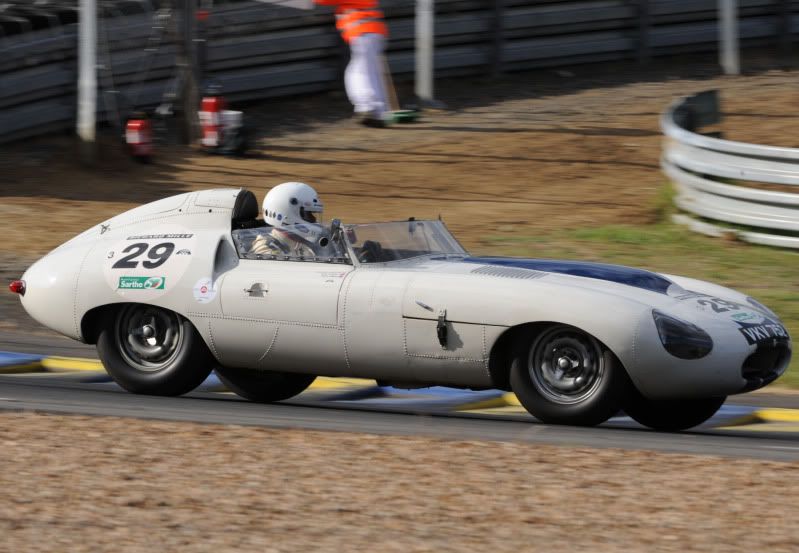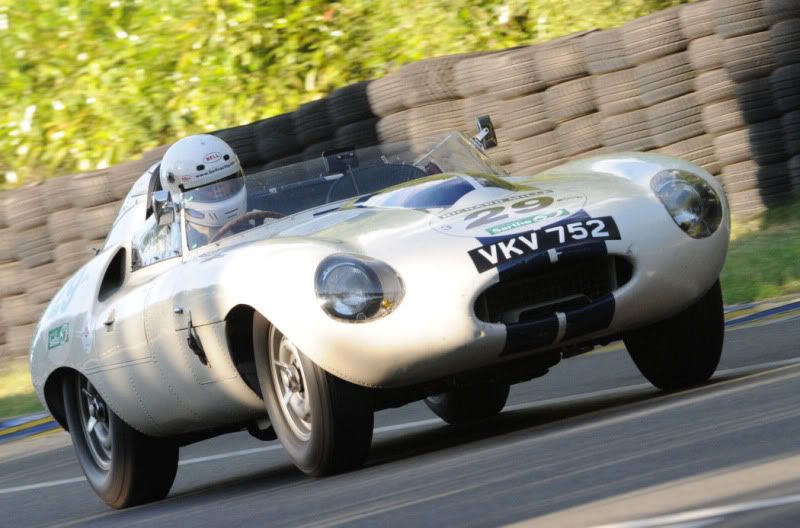too valuable to race?
Discussion
Moved from the banger racing thread.
Tony Dron brings up this subject in his column in the latest Octane. Apparently some other interest forum has been having a discussion about E2A is too important to be raced. I think it would be hard to think of anyone who cared more about the car than it's current owner and the people who are preparing it for him. The original and unique engine has been preserved but the car itself (with the 3.8L engine she used in the US) was at the classic Le Mans (I wonder whether he could find a parking space biggrin ) and I believe was due to be at Goodwood this last weekend, making it's UK début racing in front of a crowd.
I for one am glad to see the car out there being used and appreciated by fans.
PS, Paul might have some comments about the special 3L low deck engine, I seem to remember he's tried some interesting things with these engines in the past.
Tony Dron brings up this subject in his column in the latest Octane. Apparently some other interest forum has been having a discussion about E2A is too important to be raced. I think it would be hard to think of anyone who cared more about the car than it's current owner and the people who are preparing it for him. The original and unique engine has been preserved but the car itself (with the 3.8L engine she used in the US) was at the classic Le Mans (I wonder whether he could find a parking space biggrin ) and I believe was due to be at Goodwood this last weekend, making it's UK début racing in front of a crowd.
lowdrag said:
I know Stefan Ziegler, the owner of E2A, quite well, whle I wouldn't go as far as to say he is a friend. He has a lovely collection of Jaguars which race regularly and which, on occasion, have become bent. He bought E2A so that it could race again, and it aquitted itself pretty well at the Classic but, from the photos I have of Goodwood, didn't seem to be going that well. It's line through Madgwick was all on the inside, not drifting out as it would if at full chat. No matter, the car was on the track, and that's what counts. It was 50 years since it had been seen at Le Mans and people loved to see it.
There will always be this discussion on cars being "too valuable" to race, but they do and are bent and then repaired. Stefan's recommissioning of E2A was very carefully done, for instance that she didn't lose her patina, which is very important to him. Fair play to him I say. Oh, and the 3 litre engine, built expressly for the 1960 Le Mans regulations, proved, in the day, to be too fragile so that's why it races with a 3.8 litre.
But let's please not discuss this car any more under the current thread title. E2A banger racing? The very thought of it!
I've met Stafan a number of times and he is kind enough to recognise me. He is very enthusiastic about his cars and certainly seems to like them to look their age and carry their history rather than being static museum pieces that have been polished till they are dead. There will always be this discussion on cars being "too valuable" to race, but they do and are bent and then repaired. Stefan's recommissioning of E2A was very carefully done, for instance that she didn't lose her patina, which is very important to him. Fair play to him I say. Oh, and the 3 litre engine, built expressly for the 1960 Le Mans regulations, proved, in the day, to be too fragile so that's why it races with a 3.8 litre.
But let's please not discuss this car any more under the current thread title. E2A banger racing? The very thought of it!
Edited by lowdrag on Tuesday 21st September 09:10
I for one am glad to see the car out there being used and appreciated by fans.
PS, Paul might have some comments about the special 3L low deck engine, I seem to remember he's tried some interesting things with these engines in the past.
Edited by a8hex on Tuesday 21st September 10:05
a8hex said:
I for one am glad to see the car out there being used and appreciated by fans.
Well said. Cars were built to move, .I for one am very grateful that the likes of Stefan Ziegler, the Bamfords, Nick Mason and their ilk are prepared to see their cars used in the way they were meant to be.
Long may it continue.
RW774 said:
Agreed,a 3.8 is no good for E2A,that needs a all alloy motor with the correct 30 degree manifold.I don`t know why the owner does`nt go to Crosswaite and Gardener for an alloy motor.The factory did use a 3.0 version of the E with Alloy panels, alloy monoque aswell.
I'm not sure how different the casting would be for the short deck 3L block compared with C&Gs "standard" alloy XK block. Perhaps the cost was considered to extortionate. As Tony pointed out, the original was fragile, how much work would be involved in getting it right. Stafan owns the original engine too, I saw it on one of my trips down to CKL last year.
Perhaps the feeling is that this engine could too easily be destroyed in trying to make it work.
Alternatively perhaps he prefers the car with the 3.8 engine it went back the US with. The 3L engine was made specifically to work within the rules of the that years Le Mans.
RW774 said:
Agreed,a 3.8 is no good for E2A,that needs a all alloy motor with the correct 30 degree manifold.
it spent a couple of months with a 3.0 engine and 50 years with the same iron block D type engine with a prototype Lightweight E dry sump system. the bonnet was modified in 1960 for the taller 3.8 engine and Webers were fitted as Briggs Cunningham didn't want the fuel injection system it started life with. it also started life with 16 inch wheels but Briggs wanted 15 inch wheels to race in America. it now has a cut down windscreen which was done again in 1960.it now has a replica new 3.8 engine in place of the prototype 3.8 engine as all the internals of the original engine are 50 years old and completly irriplacable. the original engine can go back in any time but for now the owner wants to have some fun with the car.
E2A is staying as it has now been for a good 40+ years as when the Jaguar factory had it. it had various testing equipment for brake testing fitted at some point and was also painted Green for a short time to act as a decoy for the XJ13 project. to fit a 3.0 engine now would be completly pointless as it is nothing like it was when it ran at LeMans. but what do i know





and the 3.0 engine




it is thought that this engine was used in a 1970's motorshow alongside other Jaguar engines which might explain the wrong inlet and exhaust manifolds and the fact that everything on the engine was polished or chromed. even the spark plugs have been chromed.
I'm glad it did race. E2A was one of the deciding factors that made me go to the Le Mans Classic, and to see it close up in the paddock, and then on track was perfection.
If cars aren't being used as they were intended, then you might as well just have a picture. It annoys the hell out of me when you get all these blinkered type of people that moan about the history of things being more important than use. History didn't just stop dead when the car got sold from Jaguar - it is still being made now. There is still no better way to understand what went before than by seeing it demonstrated.
30 or 40 years from now, we're going to look back and remember 2010 as being the year E2A came back.
If cars aren't being used as they were intended, then you might as well just have a picture. It annoys the hell out of me when you get all these blinkered type of people that moan about the history of things being more important than use. History didn't just stop dead when the car got sold from Jaguar - it is still being made now. There is still no better way to understand what went before than by seeing it demonstrated.
30 or 40 years from now, we're going to look back and remember 2010 as being the year E2A came back.
MarkwG said:
I tend to think the more valuable a car, the more equity in it to fund any repairs, hence the bigger shunt that it can tolerate. I personally prefer seeing them in action, &, what man can build, can be fixed.
 A car like this is actually quite difficult to write off short of it burning down to the ground...
A car like this is actually quite difficult to write off short of it burning down to the ground...Thanks for those Tony,
Now isn't it so much better to see the car like this than sat on a pedestal "dead" and lifeless in a museum.
As Bozwell says, she now doesn't look like she was with her low deck Le Mans 3L engine.

picture from the Bonham's website
[the link on the picture doesn't work as expected, it links to the webpage, but for me at least it actually links just to the picture]
Now isn't it so much better to see the car like this than sat on a pedestal "dead" and lifeless in a museum.
As Bozwell says, she now doesn't look like she was with her low deck Le Mans 3L engine.

picture from the Bonham's website
[the link on the picture doesn't work as expected, it links to the webpage, but for me at least it actually links just to the picture]
MarkwG said:
I tend to think the more valuable a car, the more equity in it to fund any repairs, hence the bigger shunt that it can tolerate. I personally prefer seeing them in action, &, what man can build, can be fixed. The squishy lump driving the thing is a different debate, though...
How right you are. Just look at these photos of a C-type at the Le Mans Classic in 2004; the German Allard in front lost its bonnet and he swerved to avoid it at about 120mph, hit the armco onboth sides of the track, rolled several times and then caught fire. That car was back at the Classic in 2006. Value £2 million, rebuild costs £150,000. You cannot write off one of these cars.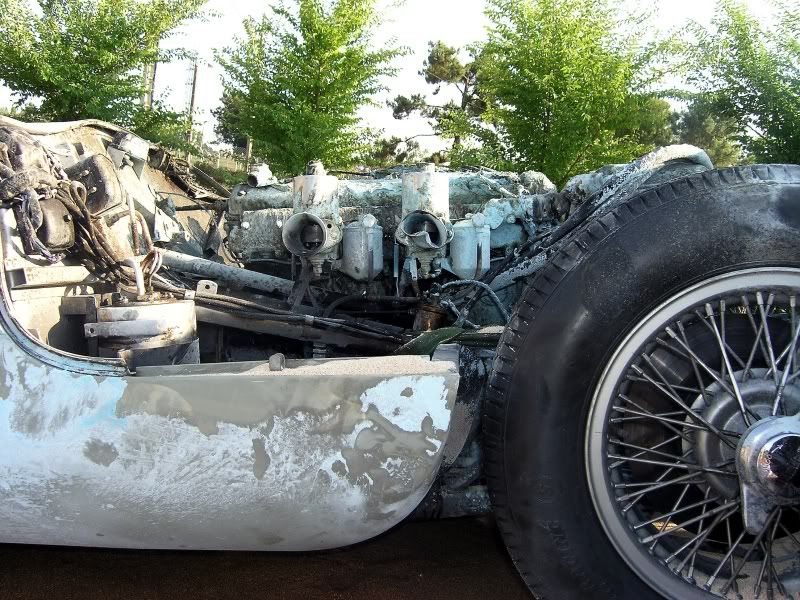
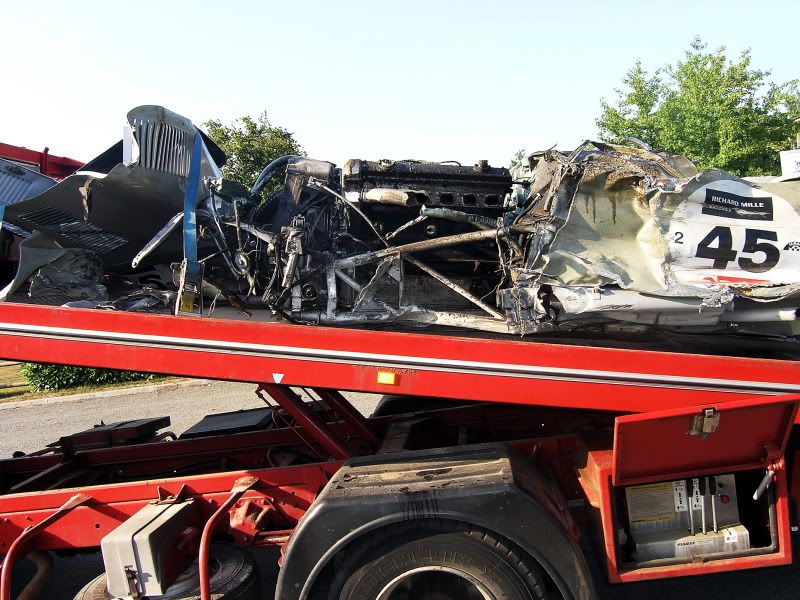


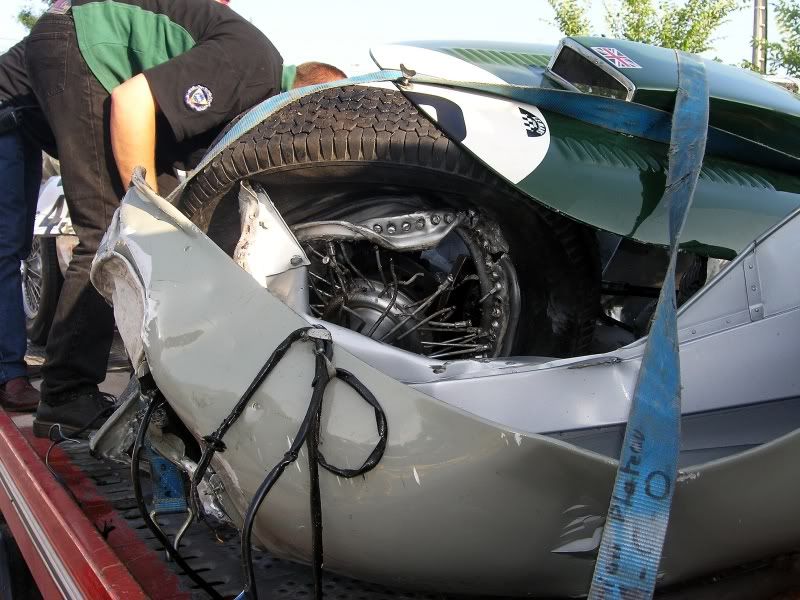
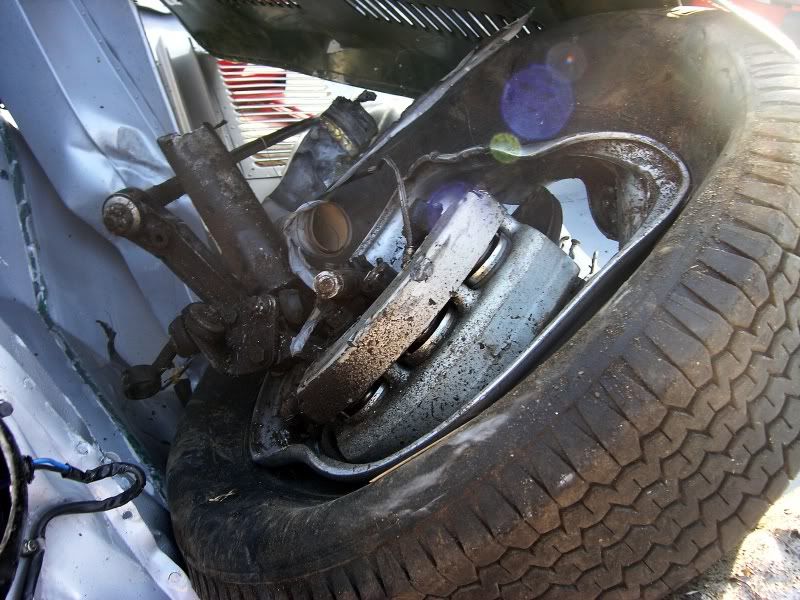
You'll see the impact was so severe the manifold was ripped off and we never found one of the front torsion bars. Not one panel was undamaged and to all intents and purposes the car was a write-off. Except of course it never can be.
Edited by lowdrag on Friday 24th September 11:25
lowdrag said:
How right you are. Just look at these photos of a C-type at the Le Mans Classic in 2004; the German Allard in front lost its bonnet and he swerved to avoid it at about 120mph, hit the armco onboth sides of the track, rolled several times and then caught fire. That car was back at the Classic in 2006. Value £2 million, rebuild costs £150,000. You cannot write off one of these cars.
You'll see the impact was so severe the manifold was ripped off and we never found one of the front torsion bars. Not one panel was undamaged and to all intents and purposes the car was a write-off. Except of course it never can be.
True, but then you get into the debate about how much of the car is the original. Is it now a £2 million car or a £150,000 replica of a £2 million car with some parts of the original incorporated?You'll see the impact was so severe the manifold was ripped off and we never found one of the front torsion bars. Not one panel was undamaged and to all intents and purposes the car was a write-off. Except of course it never can be.
Edited by lowdrag on Friday 24th September 11:25
[/quote]
True, but then you get into the debate about how much of the car is the original. Is it now a £2 million car or a £150,000 replica of a £2 million car with some parts of the original incorporated?
[/quote]
That arguement has been going on for a while...and it'll never end! Is a mini/MG thats been reshelled a replica? Is an exact copy of a D-type, rivet for rivet a replica?
Some period racing cars that many people see have been crashed/rebuilt/raced and the only part on it from when it was built originally is the steering wheel. I have nothing against these cars..and i definately see them as original. This is because at the end of the day its a racing car..and at some point it will have been crashed and rebuilt. Its just how it goes.
No-one ever questions XJ13, everyone accepts that its the one and only original, yet after the accident at MIRA not much was saved.
My opinion is - If its built exactly the same, using the same components, and the same materials, then its a "real" one. Its a new build, but still the real deal.
Both of you, Phil and Mount, are wrong in this instance. The accepted definition of a "real" car is one that has "continuous and undisputed history". This car has that, but there are many cars out there that do not. For instance, all of a sudden XKC 003 has turned up on the market. According to all records, this car was dismantled at the factory in 1952, but the pretender has suddenly reappeared 58 years later. XKD 604 is another car in point. Destroyed by Desmond Titterington at Silverstone in 1956, it reappeared in 1989 with certain parts appertaining to that car. I dispute the veracity of its existence as the original car, and to back this up the Jaguar Archivist has refused it a heritage certificate.
To go further, my C-type 1952 is an exact copy of the original, right down to Rexine upholstery and other almost unfindable parts such as the rear view mirror. It has its FIA papers and so has bee accredited as a completely correct copy of XKC 002, but it is a copy; we all know that the original was dismantled in 1952 and exists no more. The difference is about £3 million pounds; if the original existed in this form, as the only survivor of the 1952 aerodynamic C-type, it would be worth this, but mine, whatever you say, is a replica (or reconstruction would be more reasonable) of the original and isn't even worth 10% of that value.
Regardsless of accidents and rebuilds - no race car worth its salt has not had an accident at some time if continually raced - if the car has a continuous history then it it still the original, strange as that may sound. Otherwise my car would now be worth £3 million. I had a long chat with Duncan Wiltshere who runs Racing Legends and while he applauds me for what I have done, he would not let my car race in his series because it is a replica.
I accept that all of the above is a conundrum, but we have to create rules somehow, and that is how it has been done. No continuous history, not a real car.
To go further, my C-type 1952 is an exact copy of the original, right down to Rexine upholstery and other almost unfindable parts such as the rear view mirror. It has its FIA papers and so has bee accredited as a completely correct copy of XKC 002, but it is a copy; we all know that the original was dismantled in 1952 and exists no more. The difference is about £3 million pounds; if the original existed in this form, as the only survivor of the 1952 aerodynamic C-type, it would be worth this, but mine, whatever you say, is a replica (or reconstruction would be more reasonable) of the original and isn't even worth 10% of that value.
Regardsless of accidents and rebuilds - no race car worth its salt has not had an accident at some time if continually raced - if the car has a continuous history then it it still the original, strange as that may sound. Otherwise my car would now be worth £3 million. I had a long chat with Duncan Wiltshere who runs Racing Legends and while he applauds me for what I have done, he would not let my car race in his series because it is a replica.
I accept that all of the above is a conundrum, but we have to create rules somehow, and that is how it has been done. No continuous history, not a real car.
I don't know whether it was the case with this crashed C, but the "repair pool" on these cars has reached a point where the original mangled remains can be rebuilt not just replaced. Recent high profile cases covered in Octane have included CKL's rebuild of the bonnet of XKD517 from the wreckage of it's mid 50s accident. And CMCs light weight E type rebuild. Almost any piece of bent metal can be straighten given enough care/effort and skilled craftsmen.
Even in the case of humbler cars. I had the bonnet of my XK150 come open on the motorway a could of years ago. While we were waiting to get a replacement, Mike O'Shea saw it and asked RGCs if they'd talked to the man he uses for body work. A phone call later and the car was off to Coventry where it was fitted with a replacement exchange bonnet. The craftsman wanted my badly damaged one in return "Oh when things are quiet I can fix that one. The splits can all be welded up, and then it will go back in shape no problem" Wish I knew who'd fixed it, I've lost the details.
Even in the case of humbler cars. I had the bonnet of my XK150 come open on the motorway a could of years ago. While we were waiting to get a replacement, Mike O'Shea saw it and asked RGCs if they'd talked to the man he uses for body work. A phone call later and the car was off to Coventry where it was fitted with a replacement exchange bonnet. The craftsman wanted my badly damaged one in return "Oh when things are quiet I can fix that one. The splits can all be welded up, and then it will go back in shape no problem" Wish I knew who'd fixed it, I've lost the details.
a8hex - Are we talking about being "too important to be raced", as you mentioned in your opening line, or "too valuable to race", as in your thread title?
If it is value only; the decision to race and risk damage (with a subsequent diminution of value), is entirely down to the private owner.
It's when the cultural importance of an item becomes involved, that the issue of destroying an original state (not original condition) makes decisions more difficult.
I know a couple of contrasting owners who have 'historical' competition cars.
Person A has little money, he owns a nice ex-works competition car which was re-built time and time again during its ownership by the factory competition department up to the period when it was sold off some 45 years ago.
His view is that if he competed it now, any damage would hurt him financially and any re-manufactured major parts required for its repair would not be parts made by the factory during the original period when it was competing, and so would diminish its originality, as well as its value.
Person B has unlimited funds, and has a large collection of very important racing cars.
His cars are raced hard and there is no question of any meaningful financial damage in the event of a mis-hap.
I think that there is probably a good balance struck between the number of important competition cars held in collections both private and public, which are not used and are dying very very slowly, and privately owned cars whose originality is jeopodized by racing them today.
I don't think Mound Dawg is saying that the rebuilt £150,000 car is a fake; it may well have its continual history but that history should show that it now has many out of period produced parts which would diminish its value compared to say another identical car that has not suffered the same losses of period material.
One could attempt to keep all the (original) replaced parts as they come to the end of their life and keep them with the car but the chances of them being separated from their original car at some time in the future would be quite high.
Maybe the best of both worlds would be to preserve for as long as possible the
important cars in their original state by not racing them (Every event ticket says "Warning Motor Sport Can Be Dangerous .......") but then create replicas (in the real sense, such as Lowdrag's excellent Droop Snoot) and race them instead???
If it is value only; the decision to race and risk damage (with a subsequent diminution of value), is entirely down to the private owner.
It's when the cultural importance of an item becomes involved, that the issue of destroying an original state (not original condition) makes decisions more difficult.
I know a couple of contrasting owners who have 'historical' competition cars.
Person A has little money, he owns a nice ex-works competition car which was re-built time and time again during its ownership by the factory competition department up to the period when it was sold off some 45 years ago.
His view is that if he competed it now, any damage would hurt him financially and any re-manufactured major parts required for its repair would not be parts made by the factory during the original period when it was competing, and so would diminish its originality, as well as its value.
Person B has unlimited funds, and has a large collection of very important racing cars.
His cars are raced hard and there is no question of any meaningful financial damage in the event of a mis-hap.
I think that there is probably a good balance struck between the number of important competition cars held in collections both private and public, which are not used and are dying very very slowly, and privately owned cars whose originality is jeopodized by racing them today.
Mound Dawg said:
True, but then you get into the debate about how much of the car is the original. Is it now a £2 million car or a £150,000 replica of a £2 million car with some parts of the original incorporated?
There is not doubt that the more 'original' an item of historical cultural importance is, the more financial value it has.I don't think Mound Dawg is saying that the rebuilt £150,000 car is a fake; it may well have its continual history but that history should show that it now has many out of period produced parts which would diminish its value compared to say another identical car that has not suffered the same losses of period material.
One could attempt to keep all the (original) replaced parts as they come to the end of their life and keep them with the car but the chances of them being separated from their original car at some time in the future would be quite high.
Maybe the best of both worlds would be to preserve for as long as possible the
important cars in their original state by not racing them (Every event ticket says "Warning Motor Sport Can Be Dangerous .......") but then create replicas (in the real sense, such as Lowdrag's excellent Droop Snoot) and race them instead???
Oh dear, this debate goes round and round and will do in perpetuity. I think Elderly's précis above is very understandable, but for example when I sat in the very seat occupied by Duncan Hamilton and Jumbo Goddard, still with the original leather, the frisson was intense; I could almost smell the DNA and feel the car wanting to race again. I know it's purely psycological and b***s t, but if we preserve the original cars and only race replicas then we might as well create genetic clones to race them as well. No, the enjoyment is to see the real cars racing, as the above car to which I refer did at the Le Mans Classic. For years it stood in the Beaulieu museum, mouldering away, but now it lives again, doing what it was designed to do, and doing it extremely successfully too. Museums serve a purpose, but while I got intense pleasure from seeing Tutankamen's (sp?) treasures I don't really get any pleasure at all from going to a zoo. Live animals in captivity not in their native habitat, which is how I see racing cars in a museum.
t, but if we preserve the original cars and only race replicas then we might as well create genetic clones to race them as well. No, the enjoyment is to see the real cars racing, as the above car to which I refer did at the Le Mans Classic. For years it stood in the Beaulieu museum, mouldering away, but now it lives again, doing what it was designed to do, and doing it extremely successfully too. Museums serve a purpose, but while I got intense pleasure from seeing Tutankamen's (sp?) treasures I don't really get any pleasure at all from going to a zoo. Live animals in captivity not in their native habitat, which is how I see racing cars in a museum.
 t, but if we preserve the original cars and only race replicas then we might as well create genetic clones to race them as well. No, the enjoyment is to see the real cars racing, as the above car to which I refer did at the Le Mans Classic. For years it stood in the Beaulieu museum, mouldering away, but now it lives again, doing what it was designed to do, and doing it extremely successfully too. Museums serve a purpose, but while I got intense pleasure from seeing Tutankamen's (sp?) treasures I don't really get any pleasure at all from going to a zoo. Live animals in captivity not in their native habitat, which is how I see racing cars in a museum.
t, but if we preserve the original cars and only race replicas then we might as well create genetic clones to race them as well. No, the enjoyment is to see the real cars racing, as the above car to which I refer did at the Le Mans Classic. For years it stood in the Beaulieu museum, mouldering away, but now it lives again, doing what it was designed to do, and doing it extremely successfully too. Museums serve a purpose, but while I got intense pleasure from seeing Tutankamen's (sp?) treasures I don't really get any pleasure at all from going to a zoo. Live animals in captivity not in their native habitat, which is how I see racing cars in a museum.Gassing Station | Classic Cars and Yesterday's Heroes | Top of Page | What's New | My Stuff





